Advertisements
Easter Day in Canada: Origin, Traditions, Celebrations & Modern Symbols
Celebrating Easter Day in Canada? Discover the date of Easter in Canada, its historical origins, and beloved traditions. Learn how Canadians celebrate Easter today and explore the meaning behind modern Easter symbols in this festive guide!
目录
Hey there! Easter in Canada is one of those holidays that feels like a warm hug from spring itself. It’s a time when families come together, churches buzz with activity, and even the weather seems to cooperate (most of the time!). But beyond the chocolate bunnies and pastel eggs, there’s a rich tapestry of history, culture, and quirky Canadian twists that make this holiday uniquely ours. Let’s dive into everything you’d ever want to know about Easter in the Great White North—from its origins to how we party like bunnies today.
Date of Easter in Canada: A Movable Feast
Easter in Canada isn’t like Christmas or New Year’s—it doesn’t stick to a fixed calendar date. Instead, it dances around like a kid chasing an Easter egg, showing up anywhere between late March and late April. Here’s the scoop on why the date changes and how it’s calculated.
1. How Is the Easter Date Determined?
The date of Easter in Canada (and everywhere else) hinges on a combo of lunar and solar calendars. It’s always the first Sunday after the first full moon following the vernal equinox. That’s a mouthful, right? Let me break it down:
- Vernal Equinox: Usually March 20 or 21, when day and night are equal.
- First Full Moon: The Church uses an older system (the “ecclesiastical moon”) to pinpoint this, not the actual astronomical one.
- Next Sunday: Bam—that’s Easter!
For example, in 2023, Easter fell on April 9 because the full moon was on April 6, and the next Sunday was… well, you get it.
2. Why Does the Date Change Every Year?
Because the Church wanted to keep Easter tied to Passover (since Jesus’s crucifixion and resurrection happened around that time). Passover’s tied to the Jewish lunar calendar, so Easter’s date became a bit… fluid. It’s like trying to plan a picnic with your relatives who all have different schedules.
3. When’s the Earliest/Latest Easter Can Be?
The earliest Easter can be is March 22 (last happened in 1818, next up in 2285—mark your calendars!). The latest? April 25 (last in 1943, next in 2038). In Canada, we’ve seen it all: snowy Easters, sunny Easters, and even a few rainy ones that feel like the universe is crying over all the chocolate eggs melting.
4. Does the Date Affect Traditions?
You bet! A March Easter might mean ski trips and hot cocoa after church, while an April one screams for patio brunches and egg hunts in the park. Canadians adapt—we’re nothing if not resilient.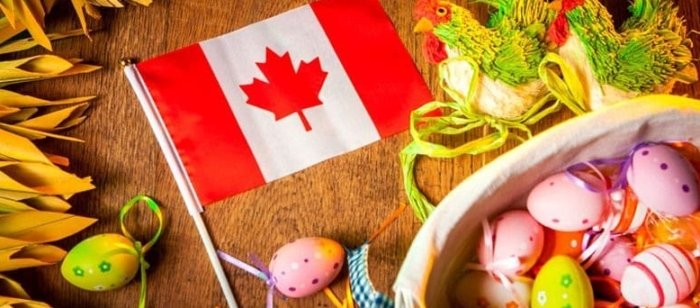
Origin of Easter: More Than Just Bunnies and Eggs
Easter’s roots run deep, way deeper than the grass where we hide those plastic eggs. Let’s peel back the layers of history, religion, and myth that shaped this holiday.
1. The Christian Connection
At its core, Easter celebrates Jesus Christ’s resurrection from the dead after his crucifixion. The word “Easter” itself might come from “Eostre,” a pagan goddess of spring, but the holiday’s Christian significance is why we go to church, have solemn Good Friday services, and reflect on sacrifice and rebirth.
2. Pagan Influences
Long before Christianity, spring festivals honored fertility and new beginnings. Eggs (symbols of life) and rabbits (prolific breeders) were everywhere. The Church blended these traditions with the resurrection story, turning pagan symbols into Christian ones. It’s like getting a new coat of paint on an old house—still the same foundation, but a fresh look.
3. The Council of Nicaea’s Role
In 325 AD, Christian leaders gathered at the Council of Nicaea to standardize Easter’s date. They wanted it to align with Passover but also avoid Jewish holidays. The result? The lunar-solar formula we use today. It was like setting a family dinner time that worked for everyone—except the date still changes.
4. How Did Easter Spread to Canada?
Early European settlers brought their Easter traditions. French Canadians blended Catholicism with folk customs, while English settlers added Anglican flair. Indigenous communities adapted, too, weaving Easter into their own spiritual practices. It’s a true Canadian mosaic—different pieces fitting together.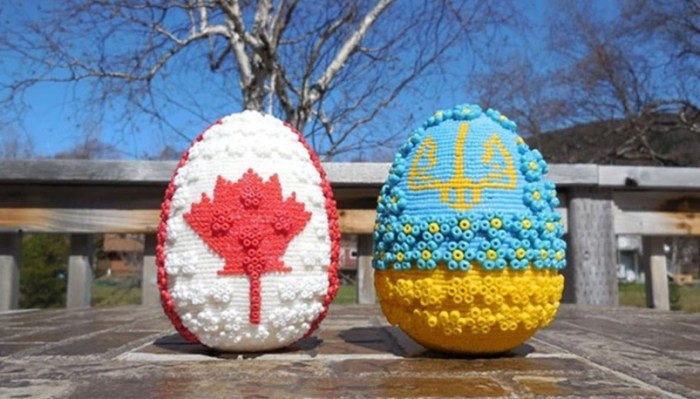
Easter Traditions: Old and New
Easter traditions in Canada are like a patchwork quilt—stitched together from centuries of history, regional quirks, and family secrets. Here’s a peek at some of our favorites.
1. Church Services
- Good Friday: A solemn day of reflection. Many Canadians attend services, and some businesses close. It’s like a pause button before the big celebration.
- Easter Sunday: Churches are packed! Kids in their Sunday best, hymns sung with gusto, and maybe a sunrise service outdoors if the weather cooperates.
- Flowers: Lilies and tulips (hello, spring!) adorn altars, symbolizing purity and renewal.
2. The Great Easter Egg Hunt
- Backyard Battles: Kids scour gardens for hidden eggs, while parents sneakily “re-hide” ones they missed.
- Community Hunts: Cities like Toronto and Vancouver host massive hunts in parks, with thousands of eggs and even appearances by the Easter Bunny.
- Golden Eggs: Some families hide a special egg with a prize inside—like a $5 bill or a “get out of chores” pass.
3. Food, Glorious Food
- Hot Cross Buns: Spiced, fruity buns marked with a cross. Some Canadians eat them on Good Friday, others all week.
- Easter Ham: The centerpiece of many dinners, glazed and roasted to perfection.
- Paskha (Ukrainian Tradition): In Ukrainian communities, this sweet cheese dessert shaped like a pyramid is a must.
4. Regional Quirks
- Newfoundland’s “Mummering”: A pre-Lenten tradition where folks dress in disguise and visit homes. It’s like Halloween but in February.
- Quebec’s “Pâques”: French Canadians might have a “réveillon” (late-night feast) after midnight mass, with tourtière (meat pie) and maple syrup.
- Prairie Provinces’ Sunrise Services: Outdoor gatherings to watch the sunrise, often followed by a pancake breakfast.
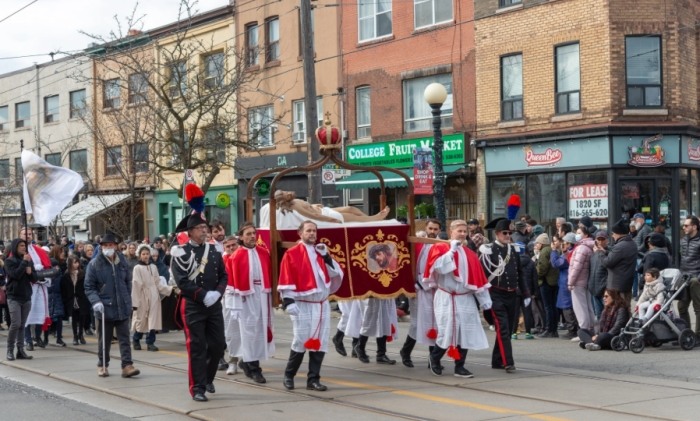
How Do Canadians Celebrate Easter? A Day-by-Day Breakdown
Easter in Canada isn’t just one day—it’s a whole weekend (or more!) of festivities. Here’s how we roll, from solemn reflection to sugar-fueled mayhem.
1. Palm Sunday: The Kickoff
- Processions: Churches hand out palm fronds, symbolizing Jesus’s triumphant entry into Jerusalem. Kids wave them like mini-flags.
- Craft Time: Many families weave palms into crosses or hearts to hang on doors.
- Food: Some regions eat fish dishes, marking the start of Holy Week.
2. Holy Thursday: The Last Supper
- Foot Washing: Some churches reenact Jesus washing his disciples’ feet, a humbling act of service.
- Altar of Repose: The Eucharist is placed on display for adoration, and churches stay open late for quiet reflection.
- Family Dinners: Roast lamb or fish, with discussions about sacrifice and gratitude.
3. Good Friday: Quiet Reflection
- Services: Many churches hold solemn services, with the cross draped in purple and readings about Jesus’s crucifixion.
- Fasting: Some Canadians skip meat or give up a treat (like coffee—ouch!).
- Stations of the Cross: Outdoor walks or indoor meditations retracing Jesus’s final steps.
4. Holy Saturday: The Waiting Game
- Easter Vigil: The biggie! Churches go dark, then light candles to symbolize Jesus’s resurrection. Baptisms and confirmations often happen here.
- Egg Dyeing: Families gather to dye eggs, turning them into psychedelic masterpieces or simple pastels.
- Baking Marathons: Hot cross buns, cinnamon rolls, and Easter breads fill the house with sweet smells.
5. Easter Sunday: Party Time!
- Sunrise Services: Early risers head to beaches or hills to greet the dawn, then tuck into breakfast burritos or pancakes.
- Easter Brunch: The main event! Ham, quiche, deviled eggs, and mimosas flow freely.
- Egg Hunts: The grand finale. Kids (and some adults) race to find eggs, while the Easter Bunny lurks nearby, snapping photos.
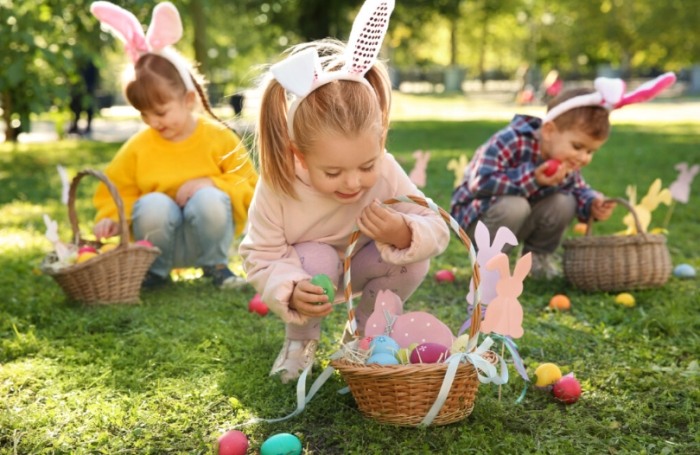
Modern Easter Symbols: From Crosses to Chocolate
Easter’s symbols have come a long way from ancient pagan rites. Today, they’re a mix of faith, fun, and commercialism. Here’s the lowdown on what we see (and eat) every year.
1. The Easter Bunny: Fluffy Icon
- Origins: German settlers brought the “Osterhase” (Easter Hare) to North America in the 1700s. Kids left carrots for the bunny, who left colored eggs.
- Modern Role: Now a marketing genius, the Easter Bunny stars in ads, parades, and even his own “eggspress” train rides.
- Controversy: Some Canadians push back on the commercialization, but let’s be real—kids love the bunny.
2. Easter Eggs: Not Just for Breakfast
- Chocolate Eggs: Cadbury’s Creme Eggs are a Canadian obsession. We hide them, hoard them, and mourn when they’re gone.
- Plastic Eggs: Filled with candy, coins, or tiny toys. Some families have egg-decorating contests with glitter, stickers, and even Sharpie art.
- The Egg Roll: At Parliament Hill in Ottawa, kids race eggs down a hill using spoons. It’s as chaotic as it sounds.
3. The Cross: Symbol of Sacrifice
- Churches: Crosses are draped in white (for purity) or flowers (for life).
- Jewelry: Canadians wear cross necklaces or bracelets year-round, but they’re especially prominent at Easter.
- Art: Community art projects, like cross-shaped flower arrangements, pop up in public spaces.
4. Lilies and Tulips: Spring’s Ambassadors
- White Lilies: Represent Jesus’s resurrection and purity. You’ll see them in churches and homes.
- Tulips: Canada’s official flower (thanks, Dutch royalty!) is a spring staple. The Canadian Tulip Festival in Ottawa even has an “Easter tulip hunt.”
- Potted Plants: Many families gift lilies or tulips as a nod to new beginnings.
5. The Easter Bonnet: A Throwback Tradition
- History: Once a fashion statement, Easter bonnets were all the rage in the 1900s. Women paraded in hats adorned with flowers, ribbons, and even live birds.
- Modern Twist: Today, some schools or community groups host bonnet-decorating contests. It’s more about creativity than couture.
- DIY Fun: Pinterest is full of tutorials for turning paper plates into “hats.” My niece once wore a bonnet shaped like a chick—adorable chaos.
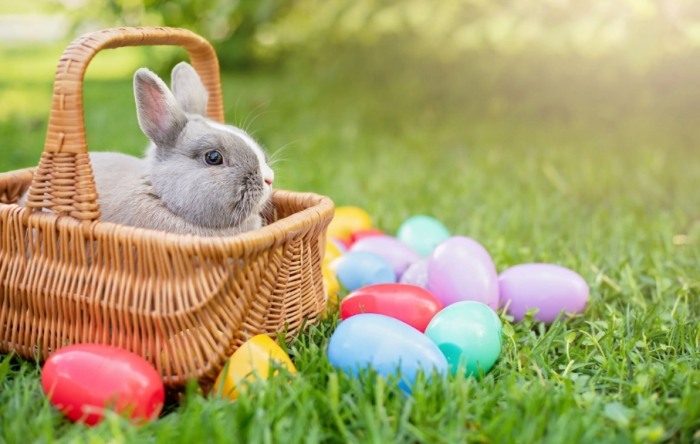
Answering Your Burning Questions
Alright, let’s tackle some FAQs about Easter in Canada. Spoiler: The answers are as diverse as our maple syrup flavors.
Q: Do you celebrate Easter in Canada?
A: Heck yeah! Whether you’re religious or not, Easter’s a big deal. Families gather, kids hunt eggs, and even the most secular Canadians can’t resist a chocolate bunny. It’s like Christmas but with less pressure and more sunshine (hopefully).
Q: How is Easter date determined in Canada?
A: It’s the first Sunday after the first full moon following the vernal equinox. Confusing? Sure. But it’s why Easter’s like a surprise party—you never know when it’ll show up.
Q: Is Easter a day off in Canada?
A: Good Friday and Easter Monday are statutory holidays in most provinces, so yeah—long weekend alert! But some jobs (like hospitals, grocery stores) stay open. Flexibility is key in Canada.
Q: Why is Easter celebrated?
A: For Christians, it’s about Jesus’s resurrection. For others, it’s a celebration of spring, family, and overindulging in candy. It’s like a spiritual reboot and a sugar rush rolled into one.
Q: Are stores closed on Easter Sunday in Canada?
A: Depends where you are. In Quebec, most stores are shut (thanks, strict labor laws). Elsewhere, malls and big-box stores might stay open, but smaller shops often take the day off. Pro tip: Stock up on chocolate eggs Saturday.
Leave a Message